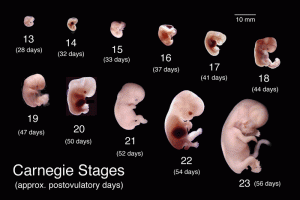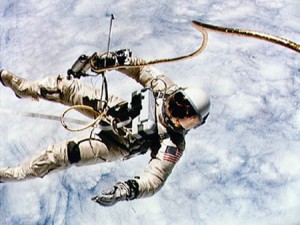Oct
30
The Pro-Life Position: Life on a SLED
“From the moment of conception, the unborn has a human nature. That he cannot yet speak, reason, or perform personal acts means only that he cannot yet function to the degree we can, not that he lacks the essential nature that makes those functions possible in the first place.” — Scott Klusendorf, in The Case for Life
In my last post, I got to the core argument for the pro-life position. While sympathetic to the emotional, financial, etc., hardships of bringing a child to term — let alone raising him/her — under difficult circumstances, I posited that the moral question outweighs all other concerns. That question comes down to: “What is the unborn?” If, as scientists & philosophers agree, the unborn is a fully alive human being from the moment of conception, then that child deserves full protection. S/he has a natural right to freedom from harm that is not properly justified.
 Many pro-choice advocates admit the unborn’s humanity from conception. But, then they try to distinguish between human non-persons that can ethically be destroyed and human persons that cannot. They assert that having qualities/abilities like reason, feelings, self-awareness, ability to feel pain, or possibly the possession of certain physical attributes (e.g., heart, brain, nervous system), is what qualifies someone (something?) as a human “person”. The unborn, at least for a time, obviously don’t exhibit these things, so they are deemed unworthy of protection. But, such requirements are arbitrary; somebody just decided that’s what they think determines “personhood”. Ask someone who argues this way why such distinctions must be made or what about them confers value on the entity in question, and they will be hard-pressed to come up with anything coherent or compelling.
Many pro-choice advocates admit the unborn’s humanity from conception. But, then they try to distinguish between human non-persons that can ethically be destroyed and human persons that cannot. They assert that having qualities/abilities like reason, feelings, self-awareness, ability to feel pain, or possibly the possession of certain physical attributes (e.g., heart, brain, nervous system), is what qualifies someone (something?) as a human “person”. The unborn, at least for a time, obviously don’t exhibit these things, so they are deemed unworthy of protection. But, such requirements are arbitrary; somebody just decided that’s what they think determines “personhood”. Ask someone who argues this way why such distinctions must be made or what about them confers value on the entity in question, and they will be hard-pressed to come up with anything coherent or compelling.
To answer many of the arguments employed by abortion advocates to devalue and dehumanize the unborn, some pro-life advocates use what is called the “SLED Test” (originally suggested by philosopher Stephen Schwarz):
“S” stands for Size. Some people don’t have a problem destroying a zygote/blastocyst/embryo/fetus, because it is so small and, in its earliest stages, doesn’t even look “human”. But since when does size matter? The average woman is smaller than the average man; are women, therefore, less human or worth less than men? The late Robert Wadlow grew to be 8’11.1″. Was he somehow more valuable as a human being than his average-sized brother? Is some 350 lb. offensive tackle more valuable than your best friend (assuming s/he isn’t of similar size, that is)? No, except to the NFL. Do we have a right to kill infants or toddlers who get to be too much trouble, too expensive, or if we decide they aren’t quite what we wanted, just because they’re smaller than us adults? Peter Singer and Richard Dawkins may think so, but most people (with a conscience) say “No!” That would be barbaric and morally reprehensible!
“L” stands for Level of Development. True, in addition to the size difference, the unborn are less developed than newborns. But, this, too, is morally irrelevant. A newborn, for that matter, is less developed than a toddler. A toddler is less developed than an adolescent. An adolescent is less developed than an adult. But we speak of and treat all of them as equally human. (Though, a child’s behavior may be “beastly”….) If personhood is only a developing, gradual thing, then we are never fully human because we continue to grow intellectually, emotionally, and (for many years, at least) physically. I would argue that the ability to perform particular human functions — including rational self-awareness — is not a necessary condition for human personhood. Rather, a person is someone with the natural, inherent capacity to commit personal acts, even if s/he lacks the current ability to perform those acts. People who are unconscious/comatose do not have the present capacity to perform personal acts. Others are physically and/or mentally challenged and thereby restricted in what they can do. We don’t just kill them because of it; nor should we kill the unborn.
“E” stands for Environment. The pro-abortion/choice argument here is to claim that the unborn is somehow less human (i.e., not a “person”) while in the womb, yet will be worthy of being called a human person once born. How does that make sense? How can/does a change in location affect what one is? What magic happens during that 6-8 inch journey down the birth canal? Does it somehow change species? No, nothing happens. “It’s not in the world, yet,” some say, “It doesn’t even breathe air.” What is it about the unborn’s method or location of respiration that diminishes her value? It doesn’t. Environment is irrelevant.
“D” stands for Degree of Dependency. For some reason, the fact that the unborn is dependent upon one person (her mother or surrogate) is supposed to make her less human, less valuable. If viability is what makes someone human or a real “person”, then anyone dependent on dialysis machines, heart pace-makers, insulin & other drugs would have to be declared non-persons. There is no ethical difference between an unborn child who is plugged into and dependent upon her mother (or surrogate) and a kidney patient who is plugged into and dependent upon dialysis. Siamese twins do not forfeit their right to live simply because they depend on shared organs or a circulatory system. Deep-sea divers and astronauts are both dependent on machines to provide them breathable air, etc., when immersed in a hostile environment. Are they any less human? Are they not “persons”?
The central point here, of course, is that the four qualities/conditions addressed in the SLED test are the only significant ways in which the born and the unborn human differ, and they are not morally sufficient reasons for thinking the unborn is less-than-human or of so little value that s/he can be eliminated for reasons of convenience. In fact, a consistent application of these criteria will leave many born people in danger for their lives, as well.
Personally (no pun intended), I’m not convinced that one can be a human and not be a “person”. We have intrinsic value by virtue of being human. This “personhood” stuff is baloney. It is specious reasoning used in an attempt to classify a subset of people as not fully human, so that others can treat them in an inhumane manner or destroy them at will, while at the same time spinning it to sound like they are doing something good and right. The same sort of reasoning was used by slaveholders to justify slavery and by Nazis & Communists to excuse oppression, vivisection, and genocide. If any of the above determines worth or full humanity, then no moral principle protects the weak and the vulnerable from the strong and the powerful.
“We cannot survive as a free nation when some men decide that others are not fit to live and should be abandoned to abortion or infanticide.” — Ronald Reagan
** Many thanks to Scott Klusendorf (www.prolifetraining.com) and Greg Koukl (www.str.org), from whom I borrowed liberally for this post.
















